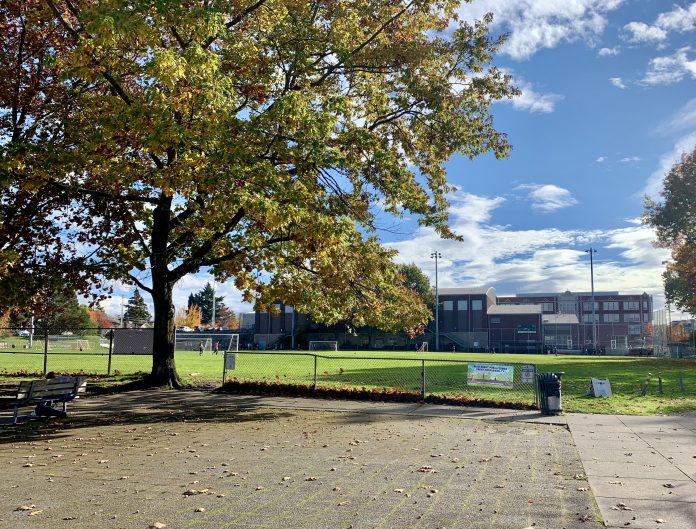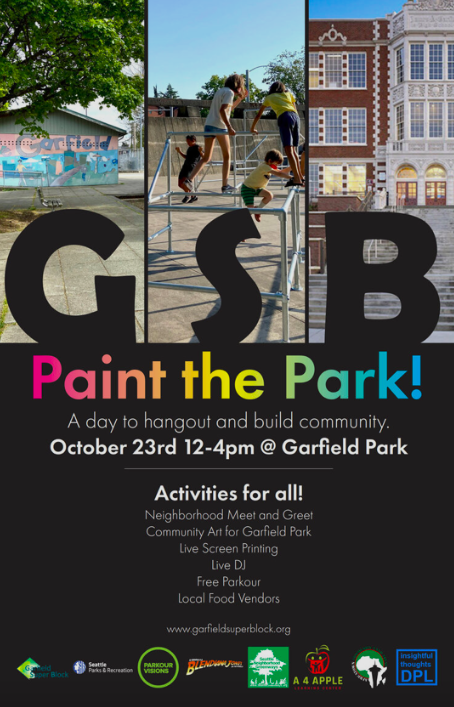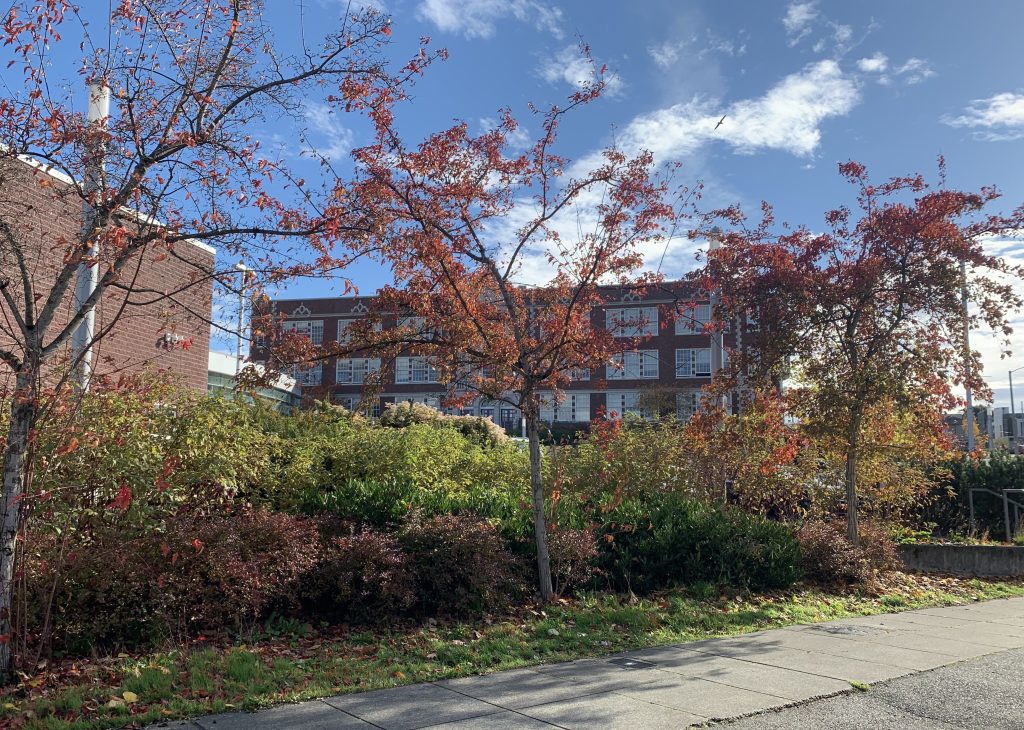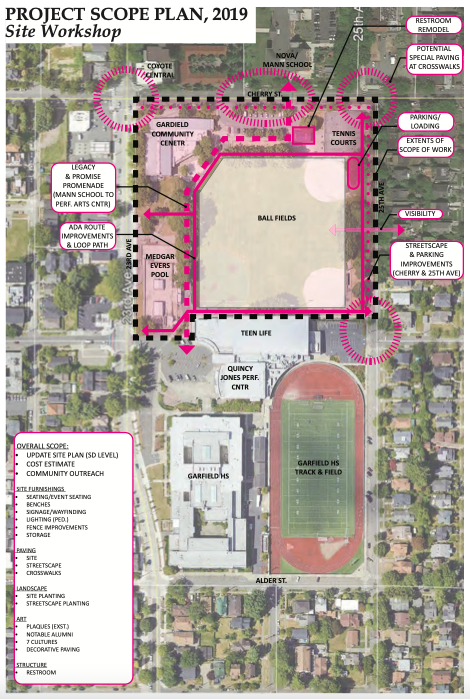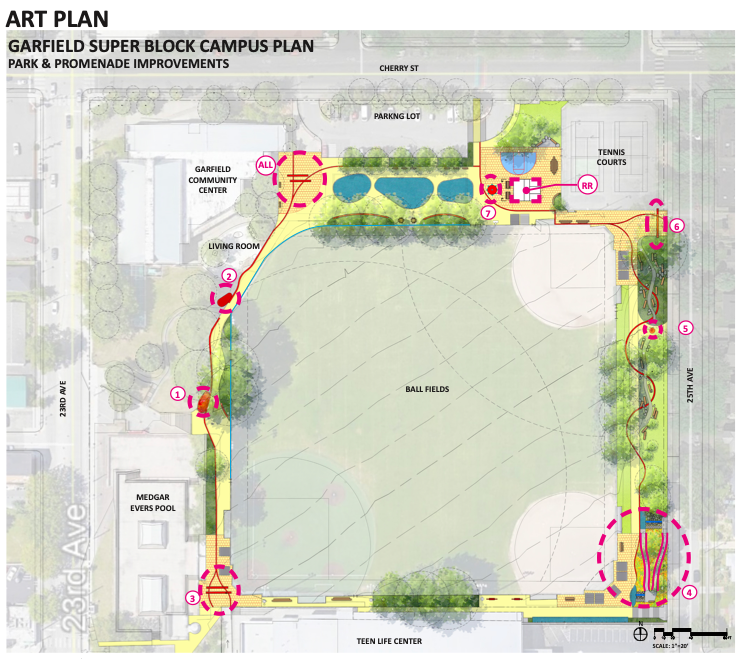Come out to celebrate the future Garfield Super Block on October 23rd, 12-4pm, at Garfield Park.
If you visit Garfield High School in Seattle’s Central District today, nearby you’ll see a large playfield flanked by a walking path that extends out to Cherry Street where it terminates in a plaza between a community center, parking lot, and playground. There’s a small community garden and voting drop box as well. Overall, it’s a remarkable spot because of the density of public services and amenities it offers. Other nearby amenities include an indoor public swimming pool, teen center, and auditorium, all located in a compact campus area. But the park itself doesn’t attract attention and the walking path simply exists as a means to get from one destination to another.
For almost two decades, however, residents of the Central District of have dreamt transforming this public space into a showcase for local history, culture, and art. Now with $500,000 in funding awarded by the City of Seattle, the long-held of vision the Garfield Super Block project is on its way to becoming reality.
This Saturday the Garfield Super Block is teaming up with Seattle Neighborhood Greenways to host a party in the future park. Attendees will be able to participate in a public art project, eat food, listen to music, show off their skills at a Parkour pop-up workshop, and learn about allied organizations like Africatown.
For advocates like Robert Stevens Jr., this day of celebration has been a long time coming. Stevens, who has lived in the Central District since the late 1950s, was one of the founders of the Garfield Park Super Block back in the early 2000s and kept the concept alive in the years that followed. When I first reached out to the current Garfield Super Block project team, they were quick to refer me to Stevens as the best person to speak to about the project’s history and vision.
Years of advocacy and community and engagement
To understand why the Garfield Super Block represents such a big win for the neighborhood, it’s important to understand its backstory. The idea first emerged in 2004 after the City of Seattle and Seattle Public Schools used an ordinance variance to build a parking lot for the Quincy Jones Auditorium on public land. In exchange, the walking path and plaza near the community center in Garfield Park were supposed to be transformed into a vibrant public space, the heart of which would showcase “a legacy and promise promenade” presenting artwork from the seven ethnic groups, Duwamish, Jewish, Black, Filipino, Chinese, Japanese, and Italian, who inhabited the Central District neighborhood during different periods of its history.
Stevens cited how it was architect Tom Bates who first took to calling the community driven revitalization effort the Garfield Super Block, a name that has stuck — recently taking on added significance as a result of hype around using superblocks as a tool for creating pedestrian friendly environments. In particular, Councilmembers Teresa Mosqueda and Lorena González have been champions of pedestrianized superblocks and proposed one in Capitol Hill. Before such ideas were in vogue, it took some doing. At the height of the early planning efforts, Bates used his own money to pay for a landscape architect to create the master plan necessary to file for a building permit with the city.
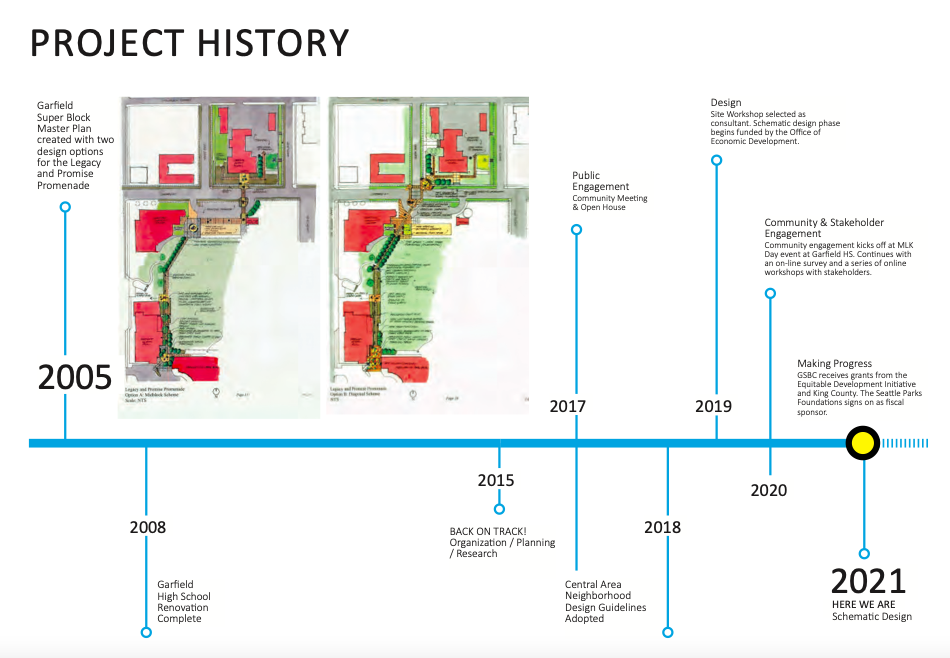
Despite the community enthusiasm, plans for the Garfield Super Block fell through for many of the usual reasons: turn over in school district staff, disagreement over what renovations were to be funded to compensate for the parking, and budget cuts all contributed to the project being passed over and forgotten.
But Stevens was not content to let the project fade away. “In certain communities the City or school gets what it needs from the community and then it forgets it made that promise. I’m one of those people who if you make me a promise I’m going to hang on to it,” Stevens said.
A closer look at design plans
Sharon Khosla, architect, and member of the Garfield Super Block team since 2019, said that $500,000 in funding will be enough to “get the project to shovel ready.”
Current plans for the Garfield Super Block combine the 2005 master plan with updated feedback from community members and stakeholders. “The idea was to carry the same intention, but through a different design,” Khosla said.
Planned Garfield Super Block improvements include:
- Replacing the current underused public restroom with a new comfort station with a community kitchen;
- Building the legacy and promise promenade, which will extend from Horace Mann School on Cherry Street all the way to the Quincy Jones auditorium;
- Building ADA-accessible route improvements;
- Replacing the current playground and adding a new water feature.
Streetscape and pedestrian improvements will extend around the entire perimeter of the playfield, which will not be changed. Otherwise, “the updates will impact every area of the park,” Khosla said.
Stevens remains excited about the plans for incorporating public art throughout the park, which will feature pieces of art created by members each of the seven ethnic groups. “I’ve got a thing about people doing other ethnic group’s art,” he said, noting that the art team has pulled an advisory group that will ensure “the art really comes from members of that community.”
Over the years, options to pursue only some of the sought improvements arose, but Stevens is glad that supporters held out until the entire Garfield Super Block would be included. “It’s not going to look right unless we have a plan for the full block area,” Stevens said. When it comes to the current plans, Stevens is pleased with where things are headed: “We are finally going to have landscaping and facilities that befit the historical significance of that park.”
Natalie Bicknell Argerious (she/her) is a reporter and podcast host at The Urbanist. She previously served as managing editor. A passionate urban explorer since childhood, she loves learning how to make cities more inclusive, vibrant, and environmentally resilient. You can often find her wandering around Seattle's Central District and Capitol Hill with her dogs and cat. Email her at natalie [at] theurbanist [dot] org.

